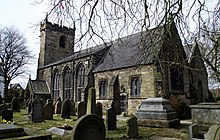St James' Church, Brindle
| St James' Church, Brindle | |
|---|---|

St James' Church, Brindle, from the southeast
|
|
| Coordinates: 53°42′48″N 2°36′32″W / 53.7134°N 2.6088°W | |
| OS grid reference | SD 599,243 |
| Location | Brindle, Lancashire |
| Country | England |
| Denomination | Anglican |
| Website | St James, Brindle |
| Architecture | |
| Status | Parish church |
| Functional status | Active |
| Heritage designation | Grade II |
| Designated | 17 April 1967 |
| Architect(s) | E. G. Paley (chancel) |
| Architectural type | Church |
| Style | Gothic, Gothic Revival |
| Specifications | |
| Materials |
Sandstone and gritstone, slate roofs |
| Administration | |
| Parish | Brindle |
| Deanery | Chorley |
| Archdeaconry | Blackburn |
| Diocese | Blackburn |
| Province | York |
| Clergy | |
| Rector | Revd David Graham Ward |
| Laity | |
| Churchwarden(s) | Steven Boult, Martin Coane |
| Parish administrator | Dr K Whyte |
St James' Church is in the village of Brindle, Lancashire, England. It is an active Anglican parish church in the deanery of Chorley, the archdeaconry of Blackburn, and the diocese of Blackburn. The church is recorded in the National Heritage List for England as a designated Grade II listed building.
The church dates back to at least the 12th century, when its rector in 1190 is recorded as being named Ughtred. Before the Reformation the church was dedicated to Saint Helen. The tower of the present church was built in about 1500. The nave was built in 1817, incorporating the former north aisle, and in the process removing the galleries. The chancel was rebuilt in 1869–70 by the Lancaster architect E. G. Paley.
Most of the church is constructed in sandstone, with the nave in dressed gritstone. The roofs are in slate. Its plan consists of a west tower, a four-bay nave that extends to the north of the tower, a south porch, and a two-bay chancel with a chapel to its north. The tower is in Perpendicular style, is in four stages, and has diagonal buttresses, and a stair turret to the southeast. In the bottom stage is a west doorway with a Tudor arch, above which is a three-light window, and a clock face. The top stage contains two-light louvred bell openings with Perpendicular tracery. On the summit of the tower is a battlemented parapet, gargoyles, and crocketed corner pinnacles.
...
Wikipedia

